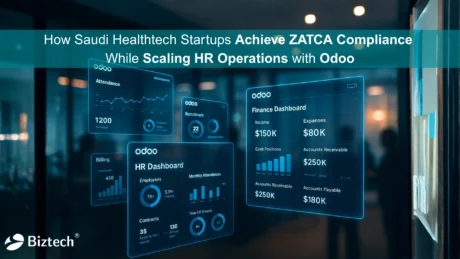2012
Why Enterprises Should Choose .NET Development in 2025
15 Jul, 2025
5 min read
2012
15 Jul, 2025
5 min read
Table of Content

Every enterprise carries a silent weight, legacy systems. They are not noisy demands for attention, but subtle drains on performance, stifling growth and hampering innovation. These systems, once built to last, are now hindering progress. The price to pay? Lost opportunities, fractured data, and delayed decisions.
Enterprise modernization is more than a technical fix; it is a strategic business decision anchored in speed, efficiency, and customer trust. Modernization does not mean complete disruption; it means replacing friction with flow. It’s here that the possibilities with .NET emerge—not merely as a development framework, but as a catalyst for transformation.
With the power to create scalable, secure, and connected solutions, .NET development services free enterprises from the constraints of legacy infrastructure. According to a Marsh McLennan study, organizations that modernize their systems can reduce technology operating costs by 25–35%, enabling more efficient and sustainable growth.
The fusion of enterprise modernization and .NET focuses on making systems smarter, leaner, and ready for the future. It transforms disjointed operations into cohesive ecosystems. It replaces patchwork with sound engineering. And most importantly, it empowers businesses to respond swiftly in a fast-paced world. This is not just a trend—it’s a turning point. And it begins by letting go of what no longer serves the business.
Doing nothing is costly, and legacy systems are hiding that cost. These systems are now outdated, and even if they are functional, their slow performance means that every delay, failed data integration, or workaround incurs additional costs. Over time, they slow progress; in fact, at some point, they stop it. What once supported growth will now act as a weight below.
The first issue that comes to mind is scalability. With increasing user demand and data volumes, legacy systems are unable to keep pace. They were not built for cloud, mobile, or real-time processing. Then, there is the integration issue: the use of modern tools on a legacy architecture are counterproductive and can lead to more costs for development.
The said maintenance was almost constant and costly. McKinsey reported that 70% of enterprises admitted that legacy systems are holding them back from adopting modern digital platforms (source). The IT departments fix legacy issues more than create value from them. Some platforms are not supported, however, creating a significant limitation in terms of compliance and operational risk.
The older it gets, the less secure it becomes. Without updates or modern encryption in place, they are easy to penetrate. Cyberattacks and data breaches are no longer a rarity, let alone incidents of the past, and legacy systems often fail to minimize the risk.
Legacy system modernization is one way to address core aspects of any challenge. It removes technical debt, simplifies infrastructure, and sets systems on the road to the next evolution. It is thus not about software replacement, but a way to restore agility, performance, and control.
Enterprise modernization is a long-term strategy-one that interchanges limitations with opportunities. This is how companies stop compensating for their systems and begin building on them. The longer the waiting time becomes, the higher the costs, and the further the organization drifts.
A system is only modern to the extent that the technology supporting it is. No matter how forward-thinking the strategy, being built on an obsolete framework will always hold it back. That’s where .NET comes in—not as a temporary fix, but as a solid scaffold for transformation. With an architecture designed for flexibility, seamless integration, and cloud alignment, .NET forms the backbone of enterprise software that scales to meet today’s demands without being weighed down by yesterday’s limitations.
At the heart of this transformation lies .NET Core, which introduces modular development concepts. These allow teams to break apart legacy monoliths into smaller, manageable services. This approach accelerates development cycles and stabilizes deployment, as enhancements can be rolled out incrementally. Instead of tackling a massive, fragile codebase all at once, organizations gain the flexibility to modernize at their own pace, minimizing risk and maximizing control.
Blazor acts as a further catalyst for modernization. It enables teams to build interactive, modern web interfaces using C#, reducing reliance on complex JavaScript frameworks. This improves development workflows and flattens the learning curve, especially valuable when internal teams are already fluent in C#.
On the cloud-readiness front, .NET is fully equipped. Azure integration facilitates seamless migration from legacy hosting environments, while built-in features like identity management, security protocols, and AI-driven services support innovation and business continuity. A Forrester study on Azure PaaS modernization found that organizations achieved up to 50% faster application development and 40% lower infrastructure costs, underlining the practical value of a modern .NET strategy.
With the right .NET development services, modernization becomes more than a simple code migration—it evolves into a strategic shift built for speed, resilience, and long-term adaptability. Whether it’s accelerating delivery, simplifying integration, or strengthening compliance, .NET provides a future-ready solution that doesn’t require enterprises to start from scratch.
For businesses ready to trade complexity for clarity, .NET enterprise solutions pave the way—transforming technical debt into technical strength.
1. Application Re-engineering
Legacy applications are often built on outdated architectures, which hinder progress. Application re-engineering refactors these systems using the latest .NET technologies. The goal is to achieve optimized performance, lower maintenance, and greater scalability, without discarding valuable business logic. It enables enterprises to retain what works while correcting what doesn’t.
2. API Development and Integration
Systems must communicate effectively, and .NET provides this capability through custom API development. APIs allow internal applications and external platforms to interact securely and efficiently. This service improves data flow, streamlines processes, and reduces manual effort, forming a solid foundation for long-term system interoperability.
3. Cloud Migration
Adopting the cloud removes the limitations of traditional infrastructure. Enterprises can migrate their systems to more scalable and reliable environments using .NET and Azure. This process includes configuring security, migrating databases, and refactoring code. The result is a more agile and cost-effective system.
4. Microservices Architecture Implementation
Monolithic applications often create performance and development bottlenecks. By implementing microservices with .NET Core, these large systems are decomposed into smaller, independent services. This modular structure enables quicker releases, facilitates easier debugging, and promotes more stable deployments. Each module can evolve without disrupting the entire system.
5. UI/UX Redesign
Outdated interfaces can harm user satisfaction and productivity. A UI/UX redesign modernizes the front end using tools like Blazor. The result is an interface that is efficient, responsive, and accessible across both desktop and mobile platforms. It’s not just about visual appeal—it’s about enhancing usability.
6. Performance Optimization
As data volume increases, system performance becomes more critical. .NET software development firms analyze code and architecture to identify inefficiencies. Through targeted refactoring, they improve response times, reduce errors, and ensure the system performs reliably under load.
7. Security Enhancements
Today’s threats demand up-to-date security measures. Enhancing security involves implementing encryption, multi-factor authentication, and compliance-based access controls. These measures are built into the .NET framework to ensure systems are secure and auditable at every level.
8. DevOps and CI/CD Enablement
Control without speed limits efficiency. DevOps and CI/CD services automate the development pipeline. By leveraging .NET-based tools, teams can achieve faster and more reliable builds, tests, and deployments, supporting continuous improvement and minimizing downtime.
9. Support and Maintenance
Modern enterprise applications require ongoing care. Support services include routine updates, performance monitoring, bug resolution, and security patches. The goal is long-term stability, ensuring systems remain healthy, secure, and ready for future scaling.
By combining these services into comprehensive .NET development services, organizations can effectively transform outdated systems into modern enterprise applications that are fast, secure, and future-ready.
1. Data Migration Complexity
Data migration from legacy systems is perhaps one of the most challenging aspects of modernizing an ERP. Organized and unstructured data are often stored in disparate formats, increasing the risk of data loss or inconsistency during transfer. .NET simplifies this process with sophisticated ETL tools and native support for SQL Server Integration Services (SSIS) and Azure Data Factory. These tools enable clean, secure, and automated data migration with minimal disruption to business operations.
2. Integration with Legacy Systems
Legacy ERP modernization frequently requires older systems to coexist with newer ones. Without proper integration, this can disrupt workflows and cause inconsistencies in reporting. .NET mitigates this issue by offering robust support for APIs, microservices, and middleware. Its compatibility with REST, SOAP, XML, and JSON enables seamless interaction between new ERP systems and existing legacy platforms.
3. User Adoption and Training
One of the less technical yet critical ERP modernization challenges is user resistance. New processes and unfamiliar interfaces can overwhelm users. .NET addresses this with frameworks like Blazor and MAUI, which support the creation of intuitive, consistent, and familiar user interfaces. These frameworks reduce the learning curve and enable rapid UI adjustments based on user feedback, leading to improved adoption rates.
4. System Downtime During Transition
Extended downtime during ERP transitions can severely disrupt operations. With .NET’s modular architecture and support for containerization, applications can be deployed incrementally. This phased rollout approach enables updates without disrupting the entire ERP environment, thereby maintaining business continuity throughout the transition.
5. Maintaining Data Integrity and Compliance
Modern ERP systems must meet stringent regulatory standards, requiring precise data accuracy, controlled access, and detailed traceability. .NET supports secure development practices and includes features such as encryption, validation, audit logging, and role-based access control. In conjunction with Azure, .NET enterprise solutions simplify compliance with regulations like GDPR and HIPAA.
Phased Rollout
Phased implementation is one of the most effective strategies for modernizing an ERP. Dividing the project into a series of manageable steps reduces risk and prevents complete system downtime. Each phase can be tested and validated independently, allowing feedback to be gathered and modifications to be made before proceeding.
Automated Testing
Automation is essential to maintaining stability during modernization. It ensures consistent quality by testing with each upgrade. Automation also reduces human error and shortens testing cycles, enabling development teams to identify issues early and release updates more efficiently.
Continuous Integration and Deployment (CI/CD)
CI/CD supports more stable rollouts. Instead of waiting for significant releases, frequent smaller versions can be deployed with reduced risk. This approach keeps development aligned with production systems, accelerating delivery without compromising reliability.
Stakeholder Engagement
Input from users and technical teams is critical to success. Engaging stakeholders ensures the solution reflects actual needs. Including both business and technical perspectives makes adoption smoother and lowers resistance to change.
Performance Monitoring
Modern systems must perform reliably from day one. Real-time monitoring enables the tracking of performance, the detection of issues early, and confirmation that the system meets expectations. This also contributes to user satisfaction and minimizes service disruptions.
.NET Development Best Practices
These methods form the backbone of trustworthy .NET development best practices. When applied together, they establish a strong foundation for transformation. From automation to integration, each step contributes to lasting, scalable modernization.
ERP Modernization Strategies That Work
Successful ERP modernization strategies are rooted in control, simplicity, and continuous improvement. With a clear plan in place, even the most complex ERP upgrades can be implemented seamlessly, transforming legacy systems into scalable, dependable platforms ready for future growth.
Legacy system modernization is more than a technical refresh—it’s a business decision with long-term consequences. With the proper application of .NET technologies, old ERP systems can be re-architected into nimble, secure, and elastic platforms. From modular design to cloud enablement, .NET provides the capabilities needed to remove constraints and enhance performance. It empowers companies to respond faster, integrate more effectively, and reduce long-term costs.
All product and company names are trademarks™, registered® or copyright© trademarks of their respective holders. Use of them does not imply any affiliation with or endorsement by them.

Odoo
49
By Uttam Jain
28 Nov, 2025

Artificial Intelligence (AI)
112
By Afzal Qureshi
27 Nov, 2025

Odoo
67
By Uttam Jain
27 Nov, 2025